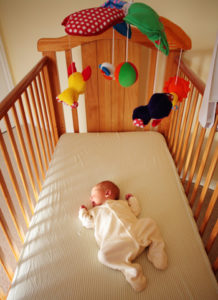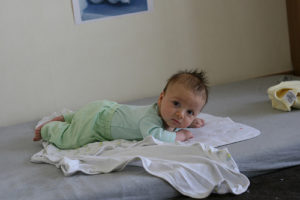October 30, 2022
Excitement, happiness, anticipation, nervousness…..these are all feelings that rush through a couple’s mind when they find out they are expecting their first child. Then the questions start flooding in: Will it be a boy or a girl? What will it look like? Will it be healthy? What do we need? This last question can be a bit daunting. However, similar to being newly engaged, couples find joy in planning for their new life together and begin making lists of all the things they would like to have. Couples start to research baby items, begin asking all of their friends with children what they like and dislike, and then rush out to make a baby registry.

One item that gives individuals the biggest headache is the baby crib. With the number of crib manufacturers making news over recent years for faulty and unsafe cribs, parents are spending hours upon hours in deliberation because their child’s life is in question. With the prices of cribs ranging from hundreds to thousands of dollars, this may be the item that couples are prepared to spend the most money on in order to guarantee their child’s safety. But with all these hours spent worrying about what crib to purchase, have expectant parents ever sat back to ask themselves: Is a crib really the best option for my child? The statistics are enough to make any parent apprehensive and it seems that every few months a different crib model is under question. Since 2007 drop-side cribs have been responsible for more than five million crib recalls in the U.S. and Canada and cribs continue to be associated with the highest child injury rates of any nursery item. Approximately 50 infants each year are killed and another 9,000 are injured in crib-related accidents in the U.S. New parents have enough to worry about without adding the stress of sleepless nights wondering if their child is safe.
Let’s put aside the horrific stats about cribs for a moment and look at their history. Early humans used to place their infants in hollowed-out trees that eventually turned into rocking cradles, similar to what we know today. Once the child outgrew that (around 3 months), he was placed on a trundle bed (small mattress) that could easily be stored under where the parents slept. By the 1800s cribs came into existence and were primarily used in North America, Europe, and Australia where families could afford homes with multi-rooms. Cribs were designed to keep the child up off the cold ground and away from drafts in these early, poorly insulated houses.
Now we will examine the specific definition of a crib: “Infant beds [cribs] are designed to restrict the baby to the bed”. This is a rather shocking statement. Is this really the hope that parents have for their children? “To restrict, to confine, to hold back, to impede, and to handicap” their child? Highly doubtful. No parent would intentionally do something to harm their child’s natural development. But if we think about it, how is it possible for the child to get into the crib? He is dependent upon the adults to place him. How does the child get out of the crib? Again, he is dependent upon the adults and has to cry to get attention. Is this the type of behavior that parents want to instill in their children? That he has to cry to get attention? Probably not.
I think it is time to look at another option. Most Montessori teachers around the world are familiar with using a Low Bed instead of a crib and those that have tried it rave about its success. Not only is this a cheaper, safer, and unrestrictive option, it provides tremendous benefits for the child’s natural development. The low bed is simply a firm, small mattress (Approx. W: 28˝ x L: 52˝ x H: 5˝) placed on the floor in the child’s room where one might imagine a crib to go. It is fitted with rubberized flannel (in case of accidents) under a tight bottom sheet, with a blanket on top to provide the child with warmth. It is imperative for parents to prepare their child’s room if they choose to go this route. Eventually, all families will have to baby-proof the entire house, so they might as well begin by making their child’s room a very safe place with a baby gate at the door if need be.

Firstly, the low bed offers the child the respect that he deserves when developing healthy sleeping habits. The child is able to wake up and fall asleep on his own, with time to explore the environment visually (without bars restricting his view). Eventually, when the child is mobile, he will be able to go to bed when tired and get up when he chooses. The child will then be free to crawl off the low bed and explore a few toys that may be displayed on a low shelf. This allows the child the opportunity to be on his own, working in concentrated activity, while at the same time letting the parents sleep in peace!
The need for providing children with a low bed originated from Maria Montessori’s many years of scientific observation. She observed children from all around the world and discovered that all individuals develop in a similar manner, regardless of time, place, or culture. She identified that every child was born with specific characteristics, which she termed “Human Tendencies”. These tendencies aid the individual in coming to understand the environment in which he lives. All of the Human Tendencies (exploration, orientation, order, movement, communication, repetition, and mathematical mind) operate naturally but if a Human Tendency is not able to function properly, the individual will not be able to develop to his full potential.
The Human Tendency for exploration is fully satisfied when providing a low bed for the child instead of a crib. Human beings have a natural tendency to explore the environment and gain knowledge from it. By allowing the child to experience his environment in this manner, he will be able to understand all of its components and will be comfortable and at ease when alone in his room. From all of this activity, the child will then become better acquainted with the world in which he lives and will arrive at the end of this process of self-construction. If we know that the process of self-construction in the child can only take place through the exploration of the environment, then this process is crucial. The child must be able to explore the environment in order to become adapted to his place and time. The child from zero to three explores the environment through the senses, but mostly through movement. By giving the child the opportunity to experience the low bed, he will benefit immensely. Not only will the child learn to function on his own, but this exposure to his environment will aid him in the development of independence, concentration, movement, self-esteem, and decision-making, leading to a healthy, well-adjusted child later on in life.
Now please sit back and ask yourself again: Is a crib really the best option for my child? I hope to have provided you with the evidence needed to further question the use of a crib in your household. But don’t worry if you currently use a crib and not a low bed for your child. The transition is actually quite easy and cheap. Just simply return the crib but keep the mattress!